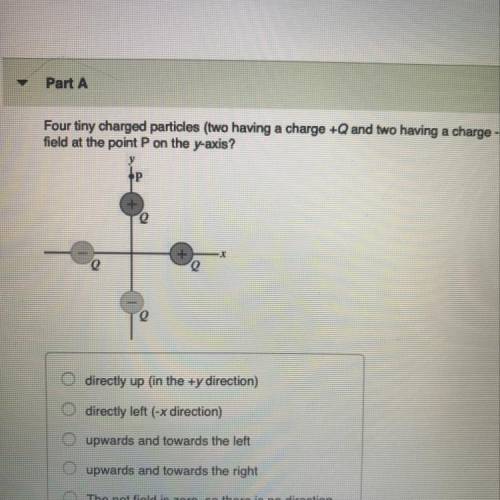
Physics, 27.05.2020 23:04 enrique3300
Four tiny charged particles (two having a charge +Q and two having a charge of -Q) are distributed on the X- and Y-axes as shown in the figure. Each charge is equidistant from the origin. In which direction is the net electric field at the point P on the y-axis?
A) directly up
B) directly left
C) upwards and towards the left
D) upwards and towards the right
E) The net field is zero, so there is no direction


Answers: 3


Other questions on the subject: Physics

Physics, 22.06.2019 05:30, shychk04ot109f
Choose the most likely outcome of this scenario: jen decided to go bike riding without a helmet. while no one is around during her ride, she is thrown from her bike when her wheel goes into a pothole. she is not injured, but she is terrified to get back on her bike. what happens next? a. her physical health is affected even though she wasn't hurt. b. her mental and emotional health are affected because she is afraid to get back on her bike. c. her social health is affected because she is worried her friends saw the fall. d. her overall health is not affected at all by her fall.
Answers: 1

Physics, 22.06.2019 14:40, viktoria1198zz
14. a body is projected with velocity vi from a. at the same time another body is projectedvertically upwards from point b withvelocity v2 lies vertically below the highestpoint. both the bodies collide thenv2÷v1is
Answers: 1

Physics, 22.06.2019 21:30, missy9225
A1500 w electric heater is plugged into the outlet of a 120 v circuit that has a 20 a circuit breaker. you plug an electric hair dryer into the same outlet. the hair dryer has power settings of 600 w, 900 w , 1200 w, and 1500 w. you start with the hair dryer on the 600 w setting and increase the power setting until the circuit breaker trips. under what setting does the circuit breaker trip.
Answers: 2

Physics, 22.06.2019 22:30, nickocasamplonp6mlob
The drag force, fd, imposed by the surrounding air on a vehicle moving with velocity v is given by fd = cdaρv 2/2 where cd is a constant called the drag coefficient, a is the projected frontal area of the vehicle, and ρ is the air density. an automobile is moving at v = 80 kilometers per hour with cd = 0.28, a = 2.3 m2, and ρ = 1.2 kg/m3.
Answers: 2
You know the right answer?
Four tiny charged particles (two having a charge +Q and two having a charge of -Q) are distributed o...
Questions in other subjects:



Mathematics, 09.11.2020 18:00



Social Studies, 09.11.2020 18:00


Mathematics, 09.11.2020 18:00

Mathematics, 09.11.2020 18:00

Mathematics, 09.11.2020 18:00



